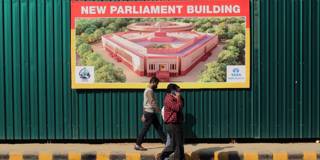India's prime minister has an "edifice complex" that has given rise to grand new government buildings, including a planned new parliament. Sadly, the spirit of deliberation and debate that animated the old parliament building risks being left there.
NEW DELHI – Indian legislators woke up in the new year to two realizations. First, the annual winter session of parliament, from which they should just have been emerging, had not taken place at all. And, second, New Delhi’s magnificent parliament complex, a tourist attraction since it was built in 1927, had been turned into a construction site.
These two facts sum up the reality of Indian democracy under Prime Minister Narendra Modi’s ruling Bharatiya Janata Party (BJP). On one hand, the government has shrugged off the very concept of accountability to the people’s representatives, the cornerstone of parliamentary democracy. On the other hand, Modi, an increasingly larger-than-life figure whose flowing beard and other-worldly air make him resemble the “Raj Rishis” or emperor-sages of ancient days, is doing all he can to transform the republic physically as well as politically. A new, grander parliament building is to arise alongside the old one, as part of his determination to leave his visible mark on the national capital.
Modi’s “edifice complex” includes plans to construct an array of new government buildings alongside New Delhi’s Central Vista, the grand sweep of which leads past parliament to the Rashtrapati Bhavan, the presidential palace. A new residential-cum-office complex for the vice president and the prime minister are also part of the plans. Environmentalists have obtained a stay on construction from the Supreme Court, but did not challenge the ground-breaking ceremony for the new parliament building to proceed.

NEW DELHI – Indian legislators woke up in the new year to two realizations. First, the annual winter session of parliament, from which they should just have been emerging, had not taken place at all. And, second, New Delhi’s magnificent parliament complex, a tourist attraction since it was built in 1927, had been turned into a construction site.
These two facts sum up the reality of Indian democracy under Prime Minister Narendra Modi’s ruling Bharatiya Janata Party (BJP). On one hand, the government has shrugged off the very concept of accountability to the people’s representatives, the cornerstone of parliamentary democracy. On the other hand, Modi, an increasingly larger-than-life figure whose flowing beard and other-worldly air make him resemble the “Raj Rishis” or emperor-sages of ancient days, is doing all he can to transform the republic physically as well as politically. A new, grander parliament building is to arise alongside the old one, as part of his determination to leave his visible mark on the national capital.
Modi’s “edifice complex” includes plans to construct an array of new government buildings alongside New Delhi’s Central Vista, the grand sweep of which leads past parliament to the Rashtrapati Bhavan, the presidential palace. A new residential-cum-office complex for the vice president and the prime minister are also part of the plans. Environmentalists have obtained a stay on construction from the Supreme Court, but did not challenge the ground-breaking ceremony for the new parliament building to proceed.